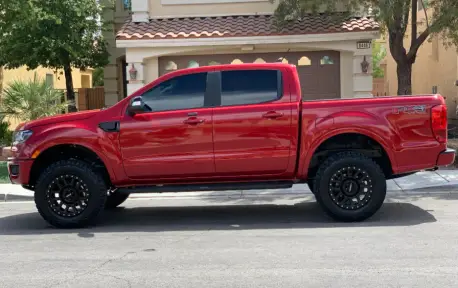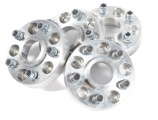
Trucks are big. And they need big wheels to match. But what goes into making sure those wheels are the right size? It all has to do with offset.
What is a truck wheel offset?

Offset is how your car's tires and wheels are positioned in the wheel wells. With zero offsets, the hub mounting surface is even with the centerline of the wheel. You'll see this a lot on older cars and trucks.
A positive offset means the hub mounting surface is closer to the outside of the wheel. A negative offset means it's closer to the inside. Most modern cars have a positive offset. Now, what does this have to do with trucks? Well, trucks are bigger than your average car. They need bigger wheels to match. And those wheels need the right offset to fit properly in the wheel wells.
A positive offset is usually used on trucks because it gives the wheels a more aggressive look. It also helps with tire clearance and keeping the truck stable on the road. But it's not the only option. Negative offset is sometimes used on trucks as well. This offset pushes the wheels out further from the body of the truck. It can give the truck a wider stance and a more muscular look.
Moreover, drivers prefer this offset because it provides more stability and grip on the road. It can also help with towing and hauling heavy loads.
No matter which offset you choose for your truck, make sure it's compatible with the rest of your truck's suspension and components. The wrong offset can cause problems down the road. So do your research and talk to a professional before making any decisions.
What is backspacing?
Backspacing is similar to offset, but with one key difference. Instead of measuring the centerline from the mounting surface of the wheel, backspacing measures the distance from the back edge of the hub. Backspacing is less popular than offset because backspace measuring has been replaced by offset in most wheel fitting procedures. Moreover, offset provides a more accurate reading of how the wheel will fit on your truck.
But if you're interested in backspacing, here's how it works. Just like with offset, a positive backspace means the hub is closer to the outside edge of the wheel. A negative backspace means it's closer to the inside edge. As with offset, most trucks use a positive backspace because it gives the wheels a more aggressive look and helps with tire clearance and stability.
Keep in mind that backspacing and offset are not the same thing. So don't get them confused when you're shopping for new wheels for your truck.

Do I want positive or negative offset?
If your offset is too high, the inside of the tire might strike your suspension. Reduce the offset to a more reasonable level to avoid this problem. The tire is moved outward as a result of this. If your offset is negative enough, the tire might rub on the fender. You'll want to increase the offset in this case. A good rule of thumb is to keep your offset between +12 and -12. This gives you enough room to play around with different looks without running into any problems.
Remember, it's important to do your research before making any decisions. Talk to a professional if you're unsure about anything. The wrong offset can cause serious problems down the road. Now that you know all about truck wheel offsets, it's time to pick the right ones for your truck. With so many options available, it's easy to get overwhelmed. But don't worry, we're here to help.
When choosing an offset for your truck, there are a few things to keep in mind. First, consider the width of your truck's wheels. The wider the wheel, the higher the offset should be. Second, think about the look you're going for. Do you want a more aggressive look or a more muscular look? Third, consider your driving style. If you do a lot of off-roading, you'll want an offset that provides more stability and grip on the road.
Now that you know all about truck wheel offsets, it's time to pick the right ones for your truck.
Will positive offset make wheels stick out?
The majority of truck wheels have a positive offset. This implies that the wheels are not always sticking out. You merely need to change the offset to a negative or less positive value to notice that the truck's wheel sticks out. The offset is usually measured in millimeters though it could be in inches.
If you want the truck wheels to appear flush with the fender, then a lower offset is better. It will make the tire sit wider on the ground and make the truck look more muscular. If your goal is to have the truck look as if it's "hugging" the road, then a higher offset will bring the tire in so it doesn't stick out as much. Just know that if your offset is too high, the inside of the tire might strike your suspension.

How do I choose the right offset?
OK, when you already know every basic thing about offsets it's time to pick the right ones. You can do it in two ways: by choosing an offset that is compatible with your truck's suspension and components or by considering the look you want to achieve. If you want to make sure the decision is correct, talk to a professional.
When selecting the truck wheel offset, first take into account the width of your truck's wheels. The wider they are, the higher the offset should be. Some drivers prefer to have a little bit of negative offset so that the wheels sit flush with the fenders. However, this can cause problems with the suspension. Second, decide what look you're going for. Do you want a more aggressive stance or a more muscular appearance? If aggressive is your thing, then a lower offset is what you're after. If you're more interested in the look of your truck, then go for a higher offset.
Third, consider your driving habits. If you do a lot of off-roading, you will want an offset that provides more stability and grip on the road. Thus, the positive truck wheel offset is more suited for this type of driving. Finally, take into account the suspension of your truck. If you have a lifted suspension, you will need a higher offset to prevent the wheels from rubbing against the fenders.
No matter which method you choose, make sure the offset is compatible with the rest of your truck's suspension and components. The wrong offset can cause problems down the road. So do your research and talk to a professional before making any decisions.
Conclusion
Drivers have many options when it comes to choosing an offset for their trucks. Now you know that there are positive, negative, and zero offsets. You also know that the decision of which offset to choose depends on the width of your truck's wheels, the look you're going for, and your driving habits. And finally, make sure the offset you choose is compatible with your truck's suspension and components.
If you have any questions about offsets or need help choosing the right ones for your truck, talk to a professional. They will be able to guide you in the right direction.
Same articles

What Are The Pros And Cons Of Wheel Spacers?
GuidesMost people don't know the importance of wheel spacers. Wheel spacers are an important part of any car, and they have a major impact on how your car handles. Wheel spacers...

How To Find The Right Wheel Spacers
GuidesIn order to upgrade your car wheels, you will need to get the help of a good wheel spacer. Wheel spacers are devices that are placed between your car's wheels and its body in order to create...

How Dangerous Are Wheel Spacers?
GuidesWheel spacers are a great way to change the look of your car, and they can also provide additional clearance for larger wheels or tires. However, if they are not installed correctly...